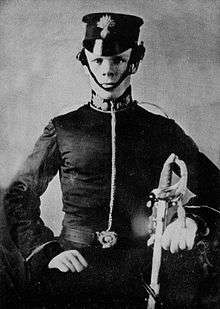Thomas Cadell
Colonel Thomas Cadell VC CB (5 September 1835 – 6 April 1919) was a Scottish recipient of the Victoria Cross, the highest and most prestigious award for gallantry in the face of the enemy that can be awarded to British and Commonwealth forces.
Thomas Cadell | |
|---|---|
 | |
| Born | 5 September 1835 Cockenzie, East Lothian |
| Died | 6 April 1919 (aged 83) |
| Buried | Tranent Churchyard |
| Allegiance | |
| Service/ | Bengal Army British Indian Army |
| Years of service | 1854 - 1892 |
| Rank | Colonel |
| Unit | 2nd European Bengal Fusiliers Indian Staff Corps |
| Battles/wars | Indian Mutiny |
| Awards | Order of the Bath |
| Other work | Governor of the Andaman and Nicobar Islands |
Cadell was the younger brother of General Sir Robert Cadell, K.C.B. and was educated at Edinburgh Academy.
VC
He was 21 years old at the time and a lieutenant in the 2nd European Bengal Fusiliers (later The Royal Munster Fusiliers) during the Indian Mutiny when he performed the deeds on 12 June 1857 at Delhi, India which resulted in being awarded the Victoria Cross:
For having, on the 12th of June, 1857, at the Flag-staff Picquet at Delhi, when the whole of the Picquet of Her Majesty's 75th Regiment and 2nd European Bengal Fusiliers were driven in by a large body of the enemy, brought in from amongst the enemy a wounded Bugler of his own regiment, under a most severe fire, who would otherwise have been cut up by the rebels. Also, on the same day, when the Fusiliers were retiring, by order, on Metcalfe's house, on its being reported that there was a wounded man left behind, Lieutenant Cadell went back of his own accord towards the enemy, accompanied by three men, and brought in a man of the 75th Regiment, who was severely wounded, under a most heavy fire from the advancing enemy.
Further information
He later achieved the rank of colonel in the service of the Indian Staff Corps and held various political appointments in India. From 1879 to 1892 was Governor of the Andaman and Nicobar Islands. He was the cousin of Samuel Hill Lawrence. The prominent Cadell Road in Bombay (now Mumbai), was named after him. After Indian Independence in 1947, it was renamed after Indian traitor Vinayak Damodar Savarkar, who was lodged at the Cellular Jail in the Andaman and Nicobar Islands.
Family
He was married to Anna Catherine Dalmahoy (d.1876), daughter of Patrick Dalmahoy WS (1798-1872) and Catherine Sawers.[2]
References
- "No. 22621". The London Gazette. 29 April 1862. p. 2229.
- Grave of Patrick Dalmahoy, Dean Cemetery
- Indian Army at www.armynavyairforce.co.uk
External links
- Location of grave and VC medal (Edinburgh)
- Thomas Cadell at Find a Grave
| Government offices | ||
|---|---|---|
| Preceded by Charles Arthur Barwell |
Chief Commissioner of the Andaman and Nicobar Islands 1878–1892 |
Succeeded by Norman Horsford |